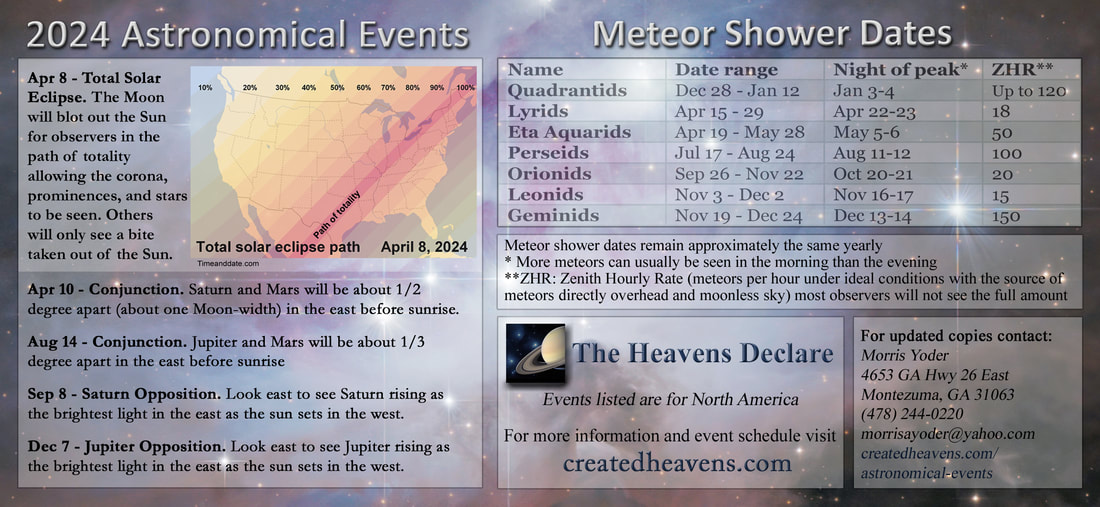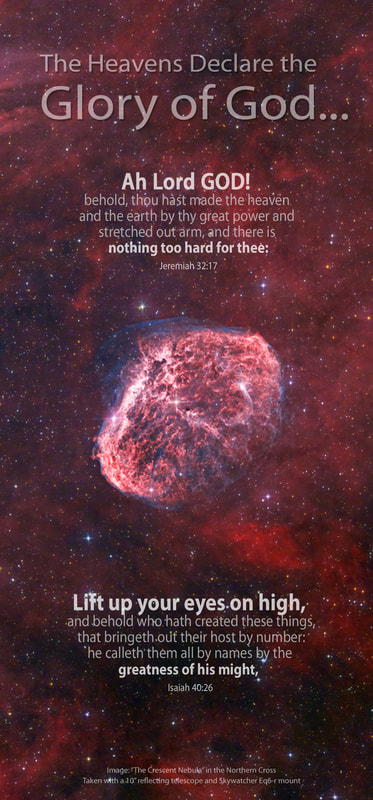Top Astronomical Events in 2024
Events listed are specifically for North America
|
Calendar of special events: end of 2023 - 2024
Dec 13, 14 (2023) - Meteor Shower. The Moon will not interfere with the Geminid meteor shower, allowing more meteors to be seen. This is likely to be the best shower of the year. Apr 8 - Total Solar Eclipse. The Moon will blot out the Sun for observers in the path of totality allowing the corona, prominences, and stars to be seen. Others will only see a bite taken out of the Sun. Apr 10 - Conjunction. Saturn and Mars will be about 1/2 degree apart (about one Moon-width) in the east before sunrise. Aug 14 - Conjunction. Jupiter and Mars will be about 1/3 degree apart in the east before sunrise Sep 8 - Saturn Opposition. Look east to see Saturn rising as the brightest light in the east as the sun sets in the west. Dec 7 - Jupiter Opposition. Look east to see Jupiter rising as the brightest light in the east as the sun sets in the west. |
Meteor Showers
Meteor showers are one of the most rewarding sights to view in the night sky with the naked eye. To observe a meteor shower, choose a spot with an unobstructed view of the entire sky and look straight up, you should be able to see meteors in any direction with your peripheral vision. The best time to observe a meteor shower is normally in the morning as the morning side of the earth is on the leading edge of the earth's orbit. More meteors are seen in the morning sky than the evening for the same reason that more bug splatters are on the front windshield of a car than are on the rear. You will also have a much better chance of seeing more meteors if the shower falls on a night when the moon is absent, this makes the meteors easier to see without the competing glare of the moon. You will probably not be able to see the ZHR (Zenith hourly Rate) amount of meteors shown on the chart below, but on average you can expect to see about half that amount. The ZHR is the approximate amount of meteors that can be seen per hour at the peak if the moon is absent, and the point where the meteors appear to be coming from is at the zenith, or directly overhead.
* Slightly more meteors can seen in the morning than in the evening
**ZHR: Zenith Hourly Rate (meteors per hour under ideal conditions with the source of meteors directly overhead and a dark, moonless sky) |
2024 Astronomical events rack cards
The astronomical events cards are passed out at all "The Heavens Declare" presentations. If you wish to have an updated card and there are no presentations near you, you can either download a copy to your computer from this web page. Alternatively, you can request one to be mailed to you free of charge by using the form at the bottom of this page.
Feel free to download a copy to your computer.
Instructions:
right click on the image, in the pop up menu left click "save image as" or "save picture as". This will open a window that allows you to save the picture to the location you choose on your computer
Instructions:
right click on the image, in the pop up menu left click "save image as" or "save picture as". This will open a window that allows you to save the picture to the location you choose on your computer



